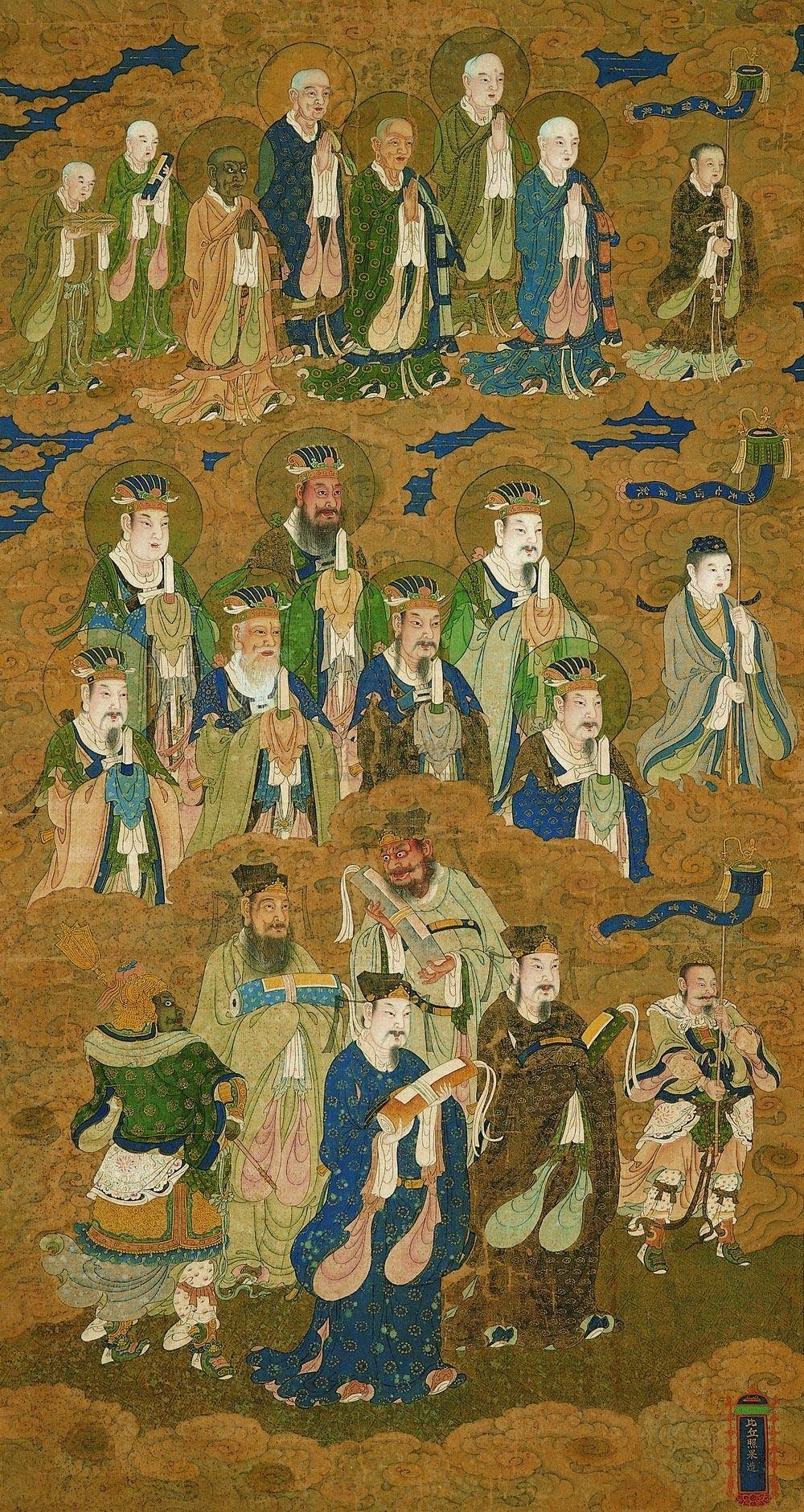
By Zheng Yuduo
Among the slew of films in the 2025 Chinese New Year slot, Ne Zha 2 has garnered the most attention and critical acclaim. This film is a sequel to the first, Ne Zha 1, which was completed after nearly five years of meticulous production.
It's easy to notice that during the film slots of important Chinese festivals, there are always films and TV productions promoting traditional Chinese cultural works and their representative characters, such as Journey to the West, Romance of the Three Kingdoms, and various kinds of martial arts novels. This time, Ne Zha, with his Wind Fire Wheel and spear, succeeded in conquering the Heavenly Court (天庭), which represents oppression, and also the audience in the cinema. In the following sections, I will introduce the authentic historical background of the film and the novel on which the film is based, Fengshen Yanyi (封神演義), and further explore the cultural symbols and emotional resonance that the character of Ne Zha represents.
Real history in Fengshen Yanyi
Fengshen Yanyi, also known as Investiture of the Gods, is set in the last years of the Shang Dynasty and the early years of the Zhou Dynasty. Shang was the second dynasty in Chinese history, and the reign of King Zhou was the last period, where his extravagance, brutality, and oppression of his subjects sparked popular discontent that eventually developed into a large-scale uprising. The leader of this uprising, Ji Fa (姬發), aided by his military advisor Jiang Ziya (姜子牙), led his army to break into Zhaoge (朝歌), the capital of Shang, destroying it and claiming the title of Emperor to establish the Zhou Dynasty.
The story depicted in Fengshen Yanyi builds on this great battle in Zhaoge. The world in the book is divided into the Immortal World and the Human World. The immortals have two main factions, Chan Jiao (闡教) and Jie Jiao (截教). The former, as a positive character, advocates moral cultivation and emphasizes morality, benevolence, and justice, with the leading figure being Yuanshi Tianzun (元始天尊); the latter, on the other hand, places emphasis on personal cultivation and pursues the growth of personal power and immortality, and as a negative character, with the leading figure being the Tongtian Jiaozhu (通天教主). In the temporal world, Ji Fa organizes an army and unites the lords to prepare for the attack on King Zhou, while Jiang Ziya, as a disciple of Chan Jiao, is sent to assist Ji Fa and is ordered to bring a list to invest the gods in the mortal world, with Yang Jian (楊戩) and Nezha as his helpers. After a great war involving both the human and immortal worlds, the Jie Jiao, which helps King Zhou, is eventually defeated, the Shang dynasty falls, Ji Fa becomes the first emperor of the Zhou dynasty, and Jiang Ziya manages to elevate the important figures of this war to the status of gods.

Nezha in Fengshen Yanyi
The Ne Zha film series, on the other hand, focuses on the life and growth of Ne Zha. As a famous fictional character in Chinese history, Ne Zha's story is similar but not identical in different works. In Fengshen Yanyi, Ne Zha, the son of General Li Jing (李靖), is born a ball of flesh and grows up with extraordinary abilities. He learns many martial arts and spells from his father and is later taken on as a disciple by the Chan Jiao immortal, Taiyi Zhenren (太乙真人). Nezha is a violent and reckless kid who once accidentally kills a disciple of an Immortal of the Jiejiao, and also kills Ao Bing (敖丙), the son of the Dragon King of the East Sea (東海龍王), in a conflict. To prevent the angry Dragon King from harming his family and innocent people, Li Jing tries to kill Nezha, Nezha is furious and kills himself by picking bones to return to his father and flesh to return to his mother. After being resurrected by Taiyi Zhenren with a lotus flower and given a variety of magic treasures, Nezha is angered by Li Jing and wishes to take revenge, but is stopped and subdued by another Chan Jiao immortal. Eventually, father and son are reconciled and Nezha follows Jiang Ziya to help crusade against the King of Zhou and achieves great success in battle.
The story told in the film is based on the book but with a substantial adaptation. In this sequel, Nezha does not kill Ao Bing but instead becomes a partner in defending himself against Chan Jiao, which is portrayed as selfish and sanctimonious. At the same time, Li Jing and Nezha are not as conflicted as they are described in the book, and suicide is not a part of the story; instead, it is reflected in the first film by sacrificing himself with Ao Bing to take down the heavenly thunderbolt and save the village.

The origin and evolution of Nezha's images
Nezha's image has survived to this day and is well known, not only for his magical powers and the story of his suicide to save his family but also for the spirit that he represents. Of course, the Nezha in the film is not the original character, nor is the one depicted in Fengshen Yanyi.
In a 1958 paper, the scholar Liu Cunren examined Nezha as a deity that came to China from Western Buddhism in the Tang Dynasty. In Buddhist scriptures, Nezha is often depicted alongside Vaiśravaṇa (毗沙門天王), which is Li Jing, one of the Four Heavenly Kings (護世四天王) known to later generations. Nezha is a ferocious Yaksha (藥叉或夜叉) with three heads and six arms, responsible for protecting the Dharma. Between the late Tang and Song dynasties, stories of Nezha's return of bones to his father and flesh to his mother began to appear.
With the spread of Buddhism in the central plains, some literary works began to incorporate the image of Nezha from Buddhist scriptures and create their versions of the character. The Yuan Dynasty saw the first literary work featuring the character of Nezha, while the early Ming Dynasty's book called Sanjiao Soushen Daquan (三教源流搜神大全) further fleshed out Nezha's image and story, which later became the basis for the stories of Nezha in the Journey to the West (西遊記) and the Fengshen Yanyi.
In Journey to the West, Nezha appears as a supporting character, and three chapters mention his origins, appearance, and battle scenes to flesh out the image and make it more vivid. In Fengshen Yanyi, Nezha's story absorbs the synopsis and image of previous stories, while the author also adds new episodes, such as the killing of Ao Bing and the battle with Shiji Niangniang (石磯娘娘), which are well-known to the modern world. This not only completes the drama and conflict of the story but also makes it more plausible for Nezha to redeem himself. Furthermore, the book emphasizes that Ne Zha suicide so as not to incriminate his family, making his image more positive and more acceptable. In this book, Nezha's story is finally integrated, his character becomes comprehensive and shaped as an embodiment of bravery, rebellion, and justice.
From birth to the present day, the story of Nezha has been refined and adapted by people from different periods, until the accomplishment of Fengshen Yanyi, his character has been stereotyped as a rebel against paternal authority and a courageous war hero.

Spirit of Nezha, the modern meaning of traditional role
By the time this article was completed, Ne Zha 2 had already grossed over RMB 10 billion at the box office, making it the largest in Chinese film history. The image of this young deity still resonates with audiences nearly 500 years later, not only thanks to the film adaptation but also because of its exuberant core. Whether it is in the film, in the Fengshen Yanyi, or even in most of the literary works featuring Ne Zha, the spirit expressed is similar, that is, resistance to feudal patriarchy and the power of the individual spirit.
In traditional works, Nezha's anger at being asked to give up his life and his revenge on his father after being resurrected is seen as a dare to stand up to patriarchal authority as an individual. In Nezha 2, the plot of Nezha's revenge on his father has been removed, but the director has taken this spirit to a new level, making Nezha and his father Li Jing rebel together against a broader patriarchal authority: the regulations of society. These regulations refer not only to the traditional senses of the father's dominance over the child and outdated lectures but also include a lot of social irrationalities: the law that the immortals are always superior and monsters are inferior, the strict class division within the Chan Jiao and the idea that "People of a different race or ethnicity can not be trusted" (非我族類其心必異) and so on. Nezha's intransigence and his awakening are also evident in the film. In Ne Zha 1, he said, "I decide whether I am a monster or an immortal", but in the second film, he says, "Yet I am a monster, so what". After experiencing many difficulties, he chooses to fight against the irrationality of the rules and stops pursuing the identity defined by Chan Jiao.
In the end, Nezha succeeds, together with Ao Bing, breaking the Ding (鼎) that symbolizes order and regulations, leading the monsters to victory and wokeness. They manage to do what the elder characters in the film and even the confused youngsters in reality dare not to, bravely challenge and reshape everything unjust. This spirit of youthful exuberance, fearlessness, and intransigence may be the very reason why modern people are attracted to watch and reflect on this film.
In conclusion, the circulation of classic stories is attributed to the adaptations made by later generations. By studying these adaptations in different eras, we can witness the social environment and trend where the adapters lived at that time, endowing a layer of historical significance to the literary works. It is precisely for this reason that we can see in Nezha, generation after generation, the changes in society, the progress of the times, and people's pursuit of equality and justice, just as in Nezha's dialogue with Ao Bing's father at end of the film goes,
"So you still want to change the world?"
"I think I'll give it a try."
The author is an assistant researcher at the Artspace K Museum.
Related News:
Nezha 2 hits 10 billion yuan box office, expresses gratitude with 100 'Thanks' on Weibo




















Comment